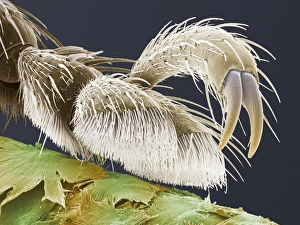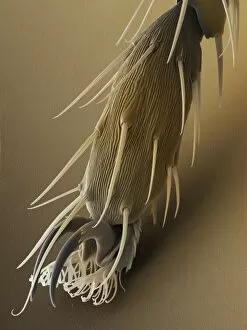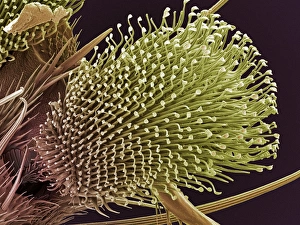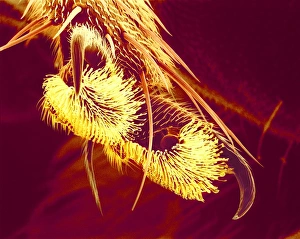"Pulvilli: The Secret to a Fly's Sticky Grip Revealed in Stunning SEM Images" Step into the microscopic world of fly feet as we explore the intricate structures known as pulvilli. These tiny appendages, captured under scanning electron microscopy (SEM), are responsible for the remarkable adhesive abilities of various fly species. Starting with the housefly foot, SEM reveals an array that resemble small cushions or pads. These specialized structures allow houseflies to effortlessly cling onto surfaces, even upside down. It's no wonder they can navigate our homes with ease. Moving on to the vine weevil foot, SEM exposes similar pulvilli arrangements but with slight variations. This adaptation enables these pests to firmly grip plant stems and leaves, causing havoc in gardens and nurseries. The fruit fly foot showcases another fascinating design under SEM. Its delicate pulvilli act like miniature suction cups, granting these tiny insects exceptional agility when landing on fruits or other food sources. Cluster flies possess unique pulvilli patterns too; their SEM images reveal densely packed structures that enhance their ability to stick onto walls and ceilings during hibernation periods. Yellow dung flies also boast impressive pulvilli adaptations seen through SEM imagery. These specialized pads aid them in navigating slippery surfaces found near animal waste sites – a vital resource for their survival. Zooming closer into a single fly's foot using powerful SEM technology unveils mesmerizing details of individual pulvillus structure. Each pad consists of numerous hair-like setae that further increase adhesion capabilities across different terrains. Horse flies exhibit robust and sturdy-looking pulvilli under SEM examination. Their strong grip allows them to land swiftly on large mammals such as horses or cattle without losing balance or being swatted away easily. Flies' feet in general present intriguing features when observed through high-resolution SEM imaging techniques. From gnats to common houseflies, each species possesses its own unique arrangement of pulvilli, enabling them to cling onto various surfaces with remarkable efficiency.










